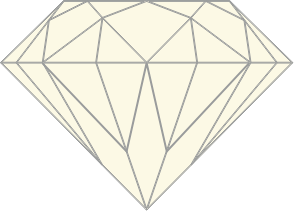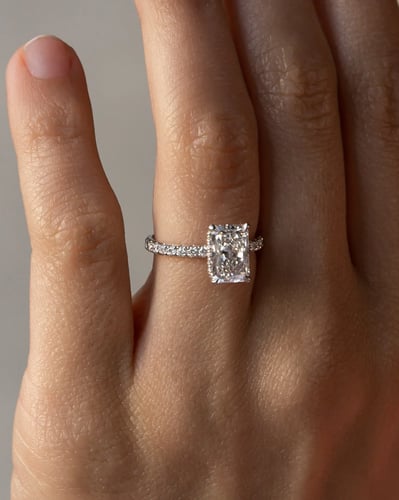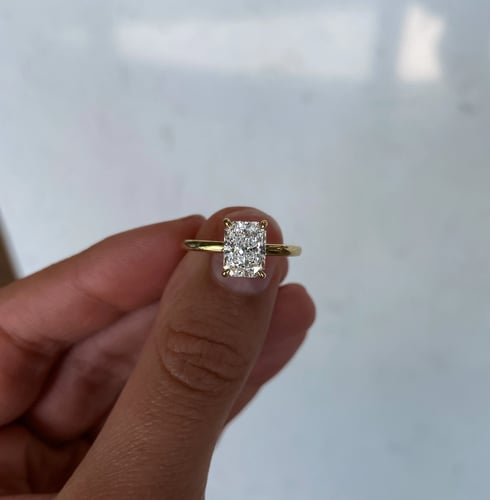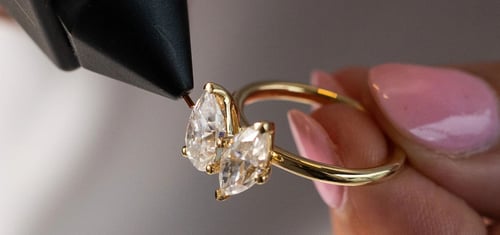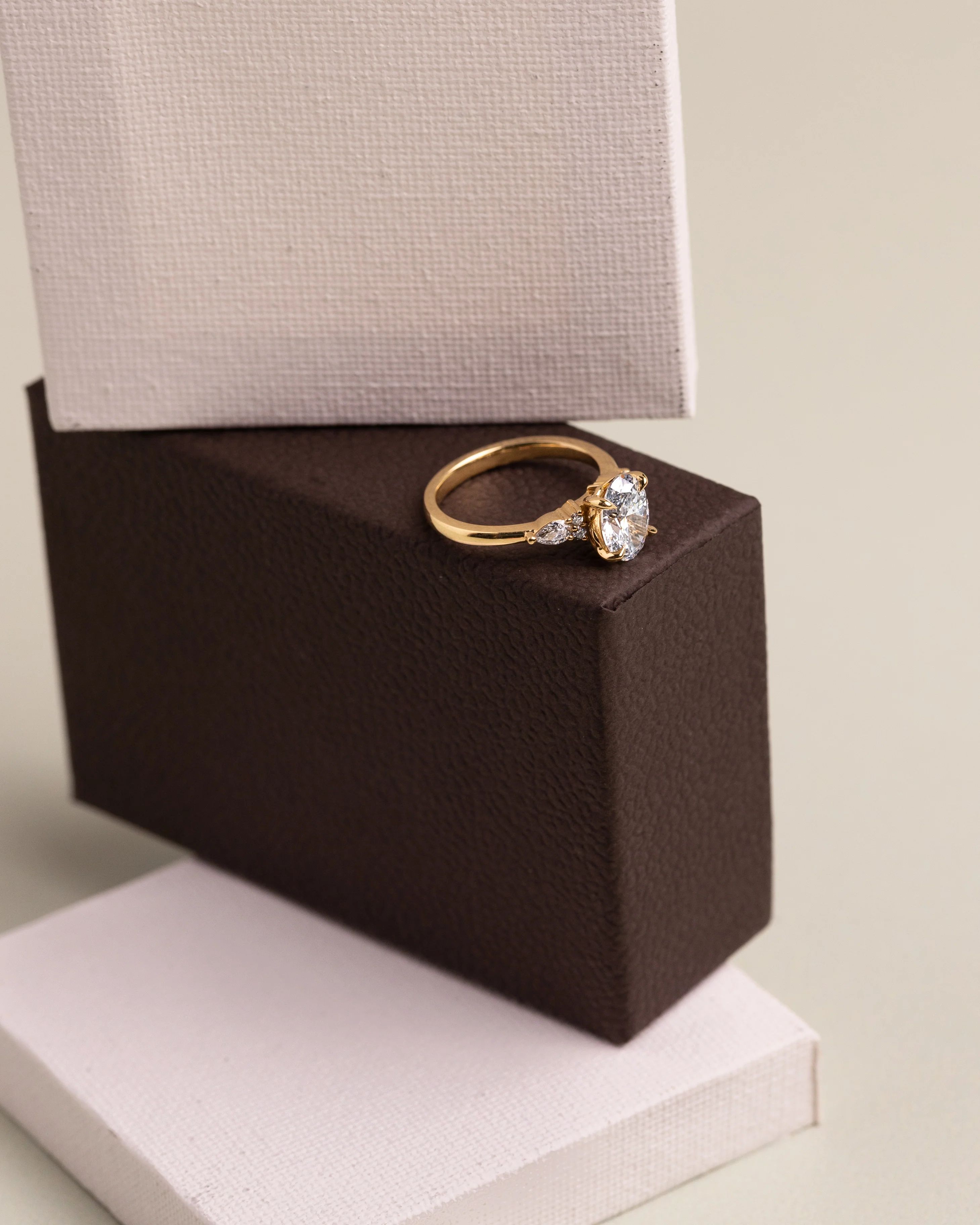
Although often compared to a diamond for its similar appearance, there is no such thing as a moissanite diamond. In the same way that an emerald or a sapphire is different to a diamond, moissanite is a real gemstone with its own unique beauty and chemical properties. Because it is a lab grown stone, moissanite is guaranteed to last as long as a diamond but can be sold at a fraction of the price. As a more sparkly, affordable and ethical choice of stone, moissanite is rapidly becoming a leading diamond alternative in the jewellery industry.

Moissanite is its own unique gemstone
With origins literally out of this world, moissanite has a unique story of discovery. First unearthed in an Arizona meteor crater by Henry Moissan in 1893, the French scientist first assumed he’d discovered diamonds. However, he soon realised that the microscopic particles were made of silicon carbide and were an entirely new discovery – a gemstone that would share his name: Moissanite!
Natural moissanite particles are extremely rare but luckily for us, modern science allows them to be beautifully replicated in controlled laboratory environments. As a lab grown stone, this makes moissanite both an ethical and eco-friendly choice. Since moissanite does not require mining, you can rest assured that your stone’s source is easily traceable and was created without the use of unethical labour practices.
Moissanite has unique physical properties
Although it can give the illusion of a diamond appearance, moissanite has subtle physical differences that separate it from a diamond and make it its own unique gemstone. This includes differences in chemical makeup, hardness, clarity, colour and brilliance.
Chemical Makeup
Unlike diamonds, which are made from carbon, moissanite is made from silicon carbide. As an extraordinarily rare, naturally-occurring mineral, it is impossible to use natural moissanite in jewellery so today’s moissanite is synthetically grown in controlled laboratory environments.


Hardness
The hardness of a gemstone is measured using the Mohs scale, where 1 is the softest and 10 is the hardest. On this scale, moissanite measures between 9.25-9.5 and is second only to diamond, which has a score of 10. As one of the hardest minerals on earth, moissanite is extremely durable and will last a lifetime of everyday wear.
Clarity
As many know, diamonds are graded according to the 4 C’s: Cut, Clarity, Colour and Carat. As a lab-produced stone, the cut and clarity of moissanite rarely varies. This means that moissanite stones will almost always be close to flawless in clarity – with very small imperfections or blemishes that can only be seen under magnification.
At Cullen Jewellery, our stones have a nearly perfect clarity grading of VVSI-2 (very very slightly included), ensuring your moissanite will have a clear, bright sparkle.
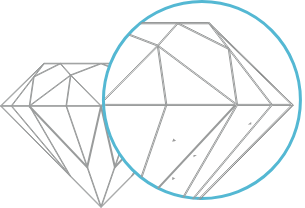
Colour
Due to the uniformity of the cut and clarity of moissanite stones, moissanite is graded solely on colour. Just like diamonds, moissanite is labelled a colourless gemstone, but may still project a yellow or gray hue in certain lighting conditions. However, this difference is extremely subtle and will only be noticeable to a trained eye when both stones are placed side-by-side.
Brilliance and Fire
Moissanite has a higher refractive index than a diamond, meaning that when light enters a moissanite stone, it will bend more than within a diamond. This means there will be more small flashes of white light (brilliance) and greater levels of dazzling colour (fire). When exposed to sunlight, a moissanite stone will sparkle brightly and may exhibit a rainbow, almost “disco-ball” effect. Compared to a diamond’s subtle blue-grey kaleidoscope pattern, moissanite’s sparkle is brighter and more dazzling – often the very quality that our clients fall in love with!


Moissanite costs a fraction of the price of diamonds
As a man-made stone, moissanite can be customised to be any shape or size and will cost a fraction of the price of a diamond of the same size and quality. Since diamonds are natural gemstones, they vary hugely in quality and are priced according to their cut, clarity, colour and carat. Moissanite, on the other hand, has very little variation in cut, clarity or colour and is priced according to size.
Because they are lab grown, moissanite stones are extremely affordable. Unlike diamonds, where prices rise steeply as soon as you start looking at large stones, larger moissanite stones increase in price in reasonable increments. To put it into perspective, for a VVSI-2 7.5mm (1.5ct) Round cut moissanite, you would pay $900 AUD whilst a diamond of the same size, clarity and colour, would cost over $9000 AUD!
This means that with moissanite, you can have the size and style that you always dreamed of without breaking the bank!
Summary
Although there are certainly visual and physical similarities between moissanite and diamonds, there is no such thing as a moissanite diamond. As its own beautiful gemstone, moissanite has origins that are literally out of this world and its own stunning fire that outshines that of a diamond. With moissanite, you will never have to sacrifice quality for price and can rest assured knowing your moissanite stone will retain its sparkle for a lifetime.
Still deciding whether moissanite is for you? Book a virtual appointment with us and we will help you decide if it's the right choice for you!
